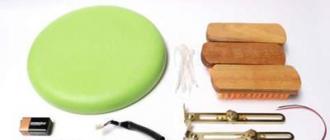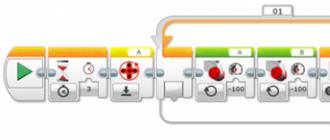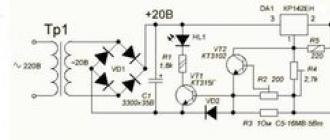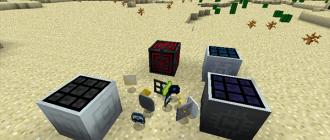How to make a GPS navigator from a laptop
Unlike many "gadgets", the laptop has a significant advantage - versatility. One and the same device can serve its owner as a working tool, an entertainment center, a music player, a cinema ... The scope of laptops is very wide. With the help of simple actions from a laptop, you can even make a GPS navigator. To do this, you need to solve only three tasks: equip a laptop with a GPS receiver, install the appropriate software and conveniently place all this in the car.
Welcome, welcome!
The GPS receiver can be connected via USB or via BlueTooth. USB GPS receiver is more convenient in terms of power supply. It does not need a battery or an additional cable to connect to the cigarette lighter, there is no need to charge such a module at home. A USB receiver can be in the form of an antenna and a wire, or it can look like a regular USB flash drive.
The second option is more compact, but there may be problems with the quality of signal reception; such an antenna cannot be placed on the dashboard and not brought out. However, modern GPS receivers are sufficiently sensitive, so in most cases you can choose any option. The BlueTooth receiver is convenient in that it can be used not only with a laptop. Such a receiver is suitable as an external GPS for a pocket computer or smartphone.
It's all about the cards
There are quite a few navigation programs that can be installed on a laptop. They differ in functionality and available cards. Listing them all is a rather tedious task, but a few words need to be said about the main programs. For off-road travel, the OziExplorer program is suitable. It allows you to use the usual scanned maps of the area. Paper maps still outperform electronic maps in terms of quality and topography details. But for driving on roads and in the city, it is better to use programs that work with electronic GPS maps.
CityGuide is famous for its high-quality and detailed map of St. Petersburg, as well as the ability to receive information about traffic jams. For GIS Russa, there are many free maps drawn by enthusiasts. Garmin MobilePC is an in-car navigation software from the world leader in navigation. The Garmin MobilePC interface is closest to a conventional car navigator and is simple and understandable even for a novice user.
Now let's try to take off with all this!
The most difficult thing is to install the laptop in the car in such a way that it does not fall or slide while driving, on sharp turns and during emergency braking. The easiest mounting option is a passenger in the next seat, holding a laptop tightly in his hands. At the same time, you can appoint him as a navigator, then the driver can not be distracted by the screen at all. You can try to fix the laptop on the dashboard using a substrate with a non-slip base. Not the most reliable option and only suitable for small laptops. You can securely install a laptop of any size using a special car bracket. Such a mount is not cheap, but the design inspires confidence and allows the driver to use the laptop on his own. without worrying about its safety.
Using a laptop as a navigator is quite justified. Large display, versatility, the ability to use different navigation programs. If we take into account that regular navigators with a large screen, which are put in place of a two-din radio, are quite comparable in price to a new mid-range and even high-class laptop, then a +GPS laptop turns out to be not only a convenient, but also an economically justified solution. Therefore, to all those who appreciate functionality and do not want to carry a bunch of different equipment with them, we recommend that you simply get a small GPS navigator for your laptop. solving the navigation problem once and for all.
The article was prepared by Susanin specialists
If you need to connect a GPS receiver to your laptop to track your location, but you don’t want to buy one, then in this article you will learn how you can use your Android phone as such a GPS receiver with the same success. Of course, the phone must have GPS and both devices must have Bluetooth, which will be used as a wireless connection.
Phone setup
In the Google Play Market, you can find many applications designed to transmit GPS coordinates via Bluetooth, for example: GPS over BT, GPS2Bluetooth, Share GPS, Bluetooth GPS Output (paid). I like GPS over BT the best, but if you can't transfer GPS data using this app, try the apps listed above.
Before launching the application, make the following preliminary settings:
- Pair your phone with your laptop via Bluetooth.
- Turn on the GPS option on your phone.
Launch the GPS over BT application, the application will automatically search for satellites, determine the location and start transmitting data to the laptop connected via Bluetooth.

To see the satellite map, press the "Menu" button of the phone and select the corresponding item.

Laptop setup
Set up a virtual serial port for a Bluetooth device on your laptop. To do this, follow these steps in Windows: open the "Devices and Printers" window (Start > Control Panel > Hardware and Sound > Devices and Printers), find the phone paired via Bluetooth among the devices connected to the laptop, right-click on it and select the command context menu "Properties".

Then, in the properties window, switch to the "Services" tab and check the box next to "Serial Port (SPP) ..." and click on the "Apply" button. After a short wait, you will see the COM port number, which you will need later to connect the GPS receiver in the navigation program for Windows.

Download and install the desired navigation application on your laptop, for example: SAS.Planet, Google Earth, 2Gis, etc. I prefer SAS.Planet (it does not need to be installed), so the GPS receiver setup for this program will be given below. In general terms, in other programs, the setting is similar.
Download, unzip and run the SAS.Planet program. Select the "GPS > Settings" command in the program window.

In the "Settings" dialog box that opens, on the "GPS" tab, make sure that "COM" is checked in the "GPS type" group. In the "Port" field, select the desired port number, the one mentioned above (in my case COM8). The speed can be left untouched, according to the documentation, when connected via the NMEA 0183 protocol at a speed of 4800 baud / s, GPS data is transmitted once per second. Press the "GPS On/Off" button, then the "Apply" and "OK" buttons.

In the main window of the program, your location should be displayed on the map, and other details (speed, distance traveled, altitude, azimuth, etc.) on the panel on the right.

The GPS-navigator ceases to be just an assistant in orienting motorists on the roads. Today, the navigator is able to determine the exact location, notify about traffic jams. The GPS receiver will provide information about the features of the terrain. To transfer data and download updated maps, the GPS navigator is connected to a desktop computer or laptop. Connection with a laptop prevails because of its mobility and versatility.
The Bluetooth function is convenient for finding a navigator by a laptop because it does not need additional equipment. Which is very convenient to save space. The GPS receiver needs to be turned on. Launch the Bluetooth function on the laptop that is on. Through the control panel, go to the "Bluetooth Devices" folder, click the "Add" button. In the list of detected devices, select the name of the navigator. Launch the setup wizard. If for some reason the wireless connection cannot be used, then a cable with a USB connector will help connect the devices. Often the GPS receiver is automatically detected by the laptop. If there is no automatic detection of the GPS navigator, you need to use the driver disk. It comes with a GPS navigator. Otherwise, drivers for the required model can be found on the receiver manufacturer's website.






Navigation on a laptop has more functionality and visibility than in portable GPS receivers. From a variety of maps, you can choose the most suitable one, quickly plan and coordinate the route.
Navigator - modern software, which allows you to determine your location in real time and display the result on the display of the device on which it is installed. This function is very useful for navigating in unfamiliar areas and planning a route to a given point. Especially navigator is in demand among car drivers, because he is able to warn in advance about traffic jams, congestion on the road and, in accordance with them, correct the path.
What are the navigators
Initially, navigators appeared as stand-alone devices, performing only the function of positioning and route planning. They are compact in size and can be easily installed in any car using a stand. The disadvantage of such devices is the inability to change or configure the software by the user. Those. the navigator worked only with a single program installed during its manufacture.
At the same time, the cost of such a device is quite high, given that it performs a single function. But with the development of technology and the advent of modern smartphones, the need for autonomous navigators has disappeared. Mobile devices based have a GPS module and support all available navigation applications. But few people know that it can also be used as a navigator.
This is quite simple to do and even an inexperienced user can complete the configuration. Using a portable PC as a navigator is beneficial from an economic point of view. You do not need to buy a separate device, but just install the required programs and start using the new features of your device.
Moreover, there are a number of laptops with a built-in GPS module:
- YOGA Book series;
- a number of laptops from the company;
- 12 Rugged Extreme;
- CF series.
What you need to know to use your laptop as a navigator
But not all laptops have an integrated GPS module. Therefore, to connect a laptop computer to a satellite system external adapter required. There are many such devices that differ in execution and connection. The most convenient are wireless GPS receivers that connect to a laptop via USB output or via Bluetooth.

Connected adapter immediately starts searching for "visible" satellites. This whole process takes up to 30 seconds. To display a map of the area and your location online, you need to run the installed navigator program for your laptop and activate the Bluetooth function (if necessary). Synchronized with the GPS receiver, the portable PC will display all the necessary information on the screen with high accuracy.
On the network, you can download several navigators on a laptop:
- GIS Russa;
- Garmin MobilePC
- OziExplorer
- CityGuide and others.
Most of them are free navigators for laptops. However, many electronic cards will have to be purchased separately for money.

Advantages of using a navigator through a laptop:
- large display and clear picture;
- the ability to install any software;
- no need to buy a separate navigator;
- compact dimensions of the GPS receiver;
Perhaps the only and significant drawback of using a laptop as a navigator is the problem of its secure fixation in the car. In such cases, it is best to take a partner with you on the road, who will hold a portable PC and at the same time tell you the way.
GPS helps people determine their location, choose the right path, plan trips and travels, and walk in unfamiliar places. GPS for a laptop is not as relevant, since this category of devices is not as mobile as tablets or smartphones. But the serious computing power of the computer allows you to implement those functions that are not available to compact gadgets. The big screen makes it easier to find the desired point and see the whole way in detail, and the GPS receiver can be connected to a serious mapping application.
What you need to install GPS in a laptop:
- The laptop itself
- USB GPS Receiver
- GPS software
Instructions for installing GPS for a laptop
- Install the GPS software. To do this, you need to run the installation file, downloaded from the Internet or located on the installation disk. In most cases, you will receive the necessary software bundled with the GPS receiver. If you have a receiver without the appropriate software, then you can buy it on the Internet or choose some free version. Another option is to try to find the necessary program on the website of the gadget manufacturer.
- Complete the installation process by following the prompts that appear on the screen. As a rule, it is enough to click the "Next" button.
- Plug the laptop GPS into an available USB port on the side or back of the laptop. Often, when installing software, the installer will ask you to do this.
- Open the installed program for navigation by double-clicking on the icon on the desktop, or find the shortcut of the program in the Start menu. If the program was bundled with the receiver, then it should automatically recognize the GPS module. Otherwise, you need to go to the program settings and find the device connected to the laptop there. Look for a wrench button or a gear in the toolbar, or find the corresponding item in the menu.
- Check the correct operation of the geopositioning system, move around the area, evaluate the sensitivity of the system. Check how quickly and accurately your location is determined.






